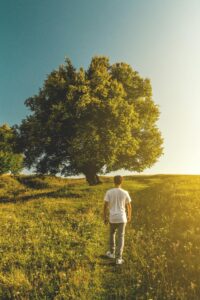Lamps, Walks, and Vitamin D
It’s that time of year again, when the days get shorter and the cool air causes all my aches and pains to rear their ugly heads: my knees, my back, my achy feet, and recurring hack. I’ve always proudly proclaimed that I enjoy all seasons, but as I get older, fall & winter have become my least favorites.
Falling back literally means falling back on my couch and falling into bed early. The end of daylight saving time leaves me feeling lazy. Even before I knew there was a name for it, I’d find myself SAD during this time of year, wanting to stay home and snuggle up on the couch.

Most of us can relate to becoming sluggish in the fall & winter. This time of year, with the holidays around the corner, brings visions of pumpkin spice, sweaters, and nights on the couch in front of the fire. But more than the cooler air is the lack of sunlight that can be depressing, making you SAD.
Do you also suffer from seasonal affective disorder?
Luckily, I’m retired now, so I don’t have to experience going to work in the dark and coming home in the dark. That was a real bummer! Now I’ll have time to get out in the sun before it gets dark. But you can still make time to get out in the sun during a lunch break or mid-day.
If you suffer from SAD, that’s your best bet: get outside whenever you can to get some vitamin D.

SAD is a real thing! It’s a form of depression that generally accompanies the end of daylight saving time and the transition into late fall and winter. If you’ve noticed you’d rather hibernate on the couch in your onesie than engage with your friends, you may be experiencing seasonal affective disorder.
This is the primary reason I vote to stop the annual time change and observe year-round daylight savings time, where the days are long. There are too many negative health implications to keep going back and forth!
A lack of sunlight disrupts the body’s internal clock and affects serotonin and melatonin levels, which are the chemicals that regulate mood and sleep. I’m the happy-go-lucky type and generally don’t have trouble sleeping. But then again, I’ve always thrived in sunlight.
When I’m home, my living room stays lit up like a Christmas tree until it’s time for bed. My partner hates it. When I visit my Mom, who lives in the dark like a vampire, I have to beg her to turn on some lamps. And when I’m in bed, my lamp is programmed to turn off at the time I go to sleep. As you can tell, I enjoy daytime and light.
So when it comes to early evenings and the accompanying darkness, I can get a bit depressed. My fix, which may work for you as well, is to be intentional about getting outside. Go for walks in the sun to soak up all the vitamin D you can.
Vitamin D
According to a Google search, the best time to go outside for vitamin D is between 10 am and 3 pm. This is when the sun’s ultraviolet B (UVB) rays are the most intense. Aim for 5 to 30 minutes of sun exposure a few times a week to get enough vitamin D on your face, arms, hands, or legs. Of course, be careful to avoid sunburn.
There’s also speculation that links vitamin D deficiency to Seasonal Affective Disorder, which is why it’s important to increase your vitamin D intake during this time of year. Incorporate foods rich in vitamin D into your diet, such as salmon, eggs, and tuna.
You might also consider taking a vitamin D supplement to help boost your levels and alleviate symptoms of SAD, particularly during the long, dark winter months. On a side note, vitamin D facilitates the absorption of magnesium, which is an essential mineral that many people often lack.
Magnesium plays a vital role in muscle and nerve function, bone health, blood sugar control, heart health, and immune function, but I digress. That’s a whole other story.
Light Therapy
I have yet to try alternative options such as light therapy or a light box, but those options make sense. A light box is meant to mimic outdoor light. It’s thought that the light used in a light box causes a chemical change in the brain that lifts your mood and eases other symptoms of SAD, such as excessive tiredness and sleeping too much. Maybe I’ll give it a try this year.
Red light therapy also offers a gentle way to ease symptoms of SAD, especially when used alongside traditional light therapy. Unlike the light box that mimics sunlight, red and near-infrared (NIR) light penetrates deeper into the body and brain, triggering cellular changes that can positively affect mood, energy, and sleep.
This process, known as photobiomodulation, stimulates mitochondrial activity, boosting ATP (energy) production and increasing blood flow in regions of the brain associated with mood regulation.
One of the key benefits of red light therapy for SAD is its ability to help reset circadian rhythms. Shorter days and reduced sunlight in fall and winter can throw off your internal clock, leading to sleep disturbances and low energy.
Clinical studies have shown that red light therapy can reduce depressive symptoms, especially when used consistently for 10–30 minutes per day. It’s also considered a safe, non-UV option with minimal side effects, making it accessible for home use with LED panels or targeted devices.
For those managing SAD, red light therapy isn’t a cure-all, but it’s a promising tool that complements other strategies like outdoor walks, vitamin D supplementation, and cognitive behavioral therapy. It’s especially helpful for people who are sensitive to bright light or want a more calming, restorative approach to light-based mood support.
Light therapy isn’t recommended for everyone, and SAD mimics other medical conditions. So, it’s important to schedule an appointment with your doctor before trying a light box or Vitamin D supplementation to address your SAD symptoms.
If you find yourself feeling low this time of year, know that you’re not alone. I’m sitting over here with my house lit up like a Christmas tree! And, no, you’re not imagining those SAD feelings.
Seasonal Affective Disorder is real, and it deserves attention and care. Open the blinds wide, chase the sun when you can, and keep your home glowing with light. Whether it’s a light box, a lamp, a vitamin D boost, or a conversation with your doctor, there are ways to feel better.
Opt outside!
Be Well, Edrika

